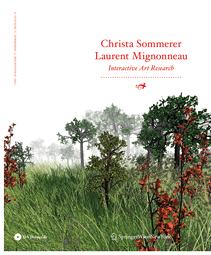David Link: Poesiemaschinen / Maschinenpoesie. Zur Frühgeschichte computerisierter Texterzeugung und generativer Systeme (2007) [German]
Filed under book | Tags: · algorithm, code poetry, digital poetry, poetry

Since the construction of the first computer in 1948, text is not only written and read, but also executed. Authors are now able to compose documents that produce content when run. “Poetry Machines / Machine Poetry” investigates the early history of these algorithmic artefacts in detail, traces them back to their literary predecessors, and emphasises the paradigms, contexts and phantasms that motivated and inspired them.
Computers are fundamentally alien to language. While Artificial Intelligence research in the 1960s and 1970s tried to overcome this difficulty unsuccessfully, text adventures used the same resistance playfully to enhance the suspense of the game. The book analyses variable scripts, Joseph Weizenbaum’s “Eliza”, Kenneth Colby’s “Parry”, early adventure games and Terry Winograd’s “SHRDLU” down to their source code, points out their metaphorical and logical structures, and places them in a genealogy of growing algorithmic complexity. The attempts are based on the belief that language and the knowledge about the world represented by it can be fully explained and even be formalised, emphatically advocated for instance in Ludwig Wittgenstein’s “Tractatus Logico-Philosophicus”. Technically, optional elements are arranged in tree-like structures and generate seemingly endless variance.
An antagonistic tradition of thought connects the dadaist Tristan Tzara, Claude E. Shannon’s re-discovery of the Russian mathematician Andrey A. Markov and the “Cut-Up” experiments of William S. Burroughs. It focuses on operations rather than on options and develops genuinely generative algorithms, which employ different routines to turn found material into collages and to produce effects unforeseen. The lacking machinic understanding of symbols transforms into poetry.
For principal reasons, the study of algorithms cannot proceed purely theoretically. As a concrete example of generative software, whose scope is by no means limited to the medium of text, Link gives an overview of a program he developed in the context of this research, “Poetry Machine”. The interactive text generator is based on semantic networks and acquires information about language autonomously from the internet. The translation of the fundamental text “An Example of Statistical Investigation of the Text ‘Eugene Onegin’ Concerning the Connection of Samples in Chains” by Andrey A. Markov, which can be regarded as the foundation of the generative approach, is given in the appendix.
Publisher Wilhelm Fink
151 pages
PDF (updated on 2014-8-29)
Comment (0)Christa Sommerer & Laurent Mignonneau. Interactive Art Research (2009)
Filed under book | Tags: · algorithm, artificial life, evolution, interactivity, interface, internet, media art, nanotechnology

Christa Sommerer and Laurent Mignonneau are two of the most innovative and internationally renowned media artists and researchers. Their work has been called “epoch-making” (Toshiharu Itoh, NTT-ICC Museum, Tokyo) for developing natural and intuitive interfaces and for applying scientific principles such as artificial life, complexity, generative systems and nanotechnologies to their innovative interface design.
This monograph represents a comprehensive overview of Sommerer and Mignonneau’s art and research. In addition to providing detailed project descriptions of each interactive artwork, it includes essays and articles by highly recognized media scholars and theoreticians who bring the interactive artworks of Sommerer and Mignonneau in an art and media art history perspective.
Contributions from Roy Ascott, Anne Marie Duguet, Oliver Grau, Erkki Huhtamo, Machiko Kusahara, Hannes Leopoldseder, Christine Schopf and Peter Wiebel, among others
Editors: Gerfried Stocker, Christa Sommerer, Laurent Mignonneau
Publisher Springer, 2009
ISBN 3211990151, 9783211990155
Length 200 pages
Kostas Terzidis: Expressive Form: A Conceptual Approach to Computational Design (2003)
Filed under book | Tags: · algorithm, architecture, design

With the increased use of computers, architecture has found itself in the midst of a plethora of possible uses. This book combines theoretical enquiry with practical implementation offering a unique perspective on the use of computers related to architectural form and design. Notions of exaggeration, hybrid, kinetic, algorithmic, fold and warp are examined from different points of view: historical, mathematical, philosophical or critical. Generously illustrated, this book is a source of inspiration for students and professionals.
Publisher Taylor & Francis, 2003
ISBN 0415317436, 9780415317436
Length 90 pages

